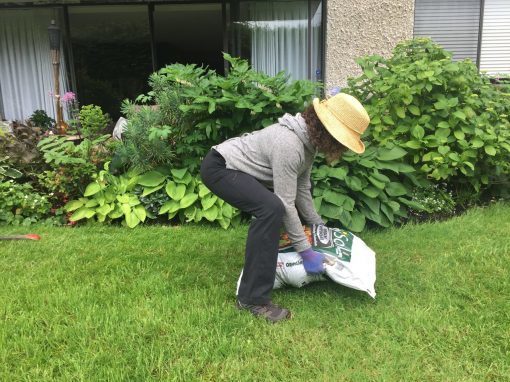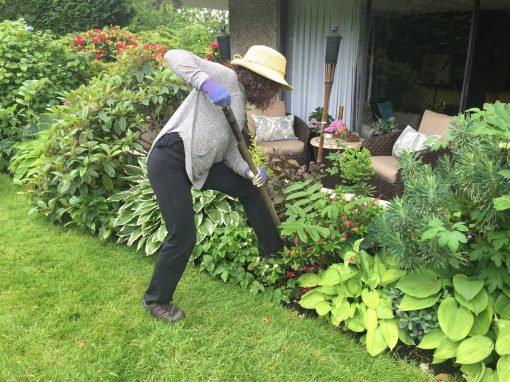
“I hinged and dug, and dug and fought hard with the roots. I pulled mightily on them and I wrestled with the root ball and nearly fell back. I got set again as I was going to win this battle! Determined to dig it out no matter what it took. Despite the stronghold Mother Earth had on this diseased plant I was going to succeed!” ~ Sheila 2017
Recalling my story to Leanne Johnson, Chief Operating Officer of GardenWorks recently, she laughed and said that happens all the time. “And then you stand up not knowing if your back is going to be a question mark or not!” she says.
In her systematic review of the benefits of gardening author Donna Wang reveals that gardening can be an activity that promotes overall health and quality of life, physical strength, fitness and flexibility, cognitive ability, and socialization. I love the idea that gardening is considered a health-promoting activity that transcends both urban and rural communities, individuals, and groups.
There is the idea that you can garden to become fit when you really need to be fit to garden!
When we treat gardening like leisure time the physical loads we carry, shovel, load, bend, twist, and pull are risk factors for low back pain. Strong evidence exists that many gardeners overdo it and end up requiring treatment for a host of injuries including gardeners’ back, hedge shoulder, weeder’s wrist, pruner’s neck, kneelers knee, and more.
Let’s face it, gardeners get the job done one way or the other. Although we all benefit from their labor of love, if you see yourself in this picture I suggest you read on to keep the green thumb alive and moving well!
I asked Dr. Olson from Edgemont Chiropractic if there was a similarity between gardening injuries and the snow shoveling injuries he sees in the winter. “Yes, there is – it’s a strength, fitness, and lack of awareness on how to move properly, the way the body was designed to move,” states Dr. Olson. “Overdoing it the first time out is something we often see in the clinic, then patients end up being sore the majority of the summer, limiting the gardening they can actually do!”
The rules for proper movement and safely loaded training in the fitness and gym environment apply to the gardener as well. Gardening is a dangerous sport and often leads to back injuries as well as repetitive stress injuries to many other parts of the body. Didn’t we mention hands, wrists, elbow, shoulder, hip, and knees already?
So people are good at over-doing it and then end up on the doctor’s doorstep for the fix. It’s easy to get in the zone to get things done but preparing yourself to be stronger and move well as an overarching principle for your life will reduce the risk of injury, pain, and downtime from doing the things that you love.
Our Best Gardening Tips:
- Do warm-up exercises before hitting the garden. Foam rolling, glute bridges, planks, arm movements, squats, and walking.
- Avoid excessive stretching before exercise/gardening as it may make muscles weaker.
- Use movement patterns learned in the gym to bend over while weeding and lifting bags of soil out of the car. That means hinge with your hips and brace your core with breath while lifting pots and plants.
- Keep the object as close to you as possible.
- Get strength from the glutes and hips.
- Changing positions often and take breaks/stretching every 15-20 min. Gives your body a break and avoids overuse injuries/stiffness.
- Don’t bend over weeding for more than 20 minutes at a time – the stretch on your back ligaments will cause the muscles to tighten up and hurt later. Consider using the half-kneeling position for weeding. (See picture below.)
- Don’t do any heavy lifting after a period of being bent over – e.g. – weeding – the back is very vulnerable after periods of full spinal flexion.
- Brace your torso/core while digging to ensure maximum strength and energy transfer to the arms and legs while stabilizing and supporting the spine. Be mindful of twisting with a load as rotation and flexion combined can be very problematic for your back.
- Keep hydrated while gardening.
- Make sure to stretch/cool down after gardening. You just had yourself a workout.
- Watch your grip on pruners and tools. Over gripping is a sign of a weak core!
- Don't try to move those heavy pots on your patio by pushing them with your foot and leg. Use a hip hinge and lift or push.
- Be careful with overhead positions, especially when you are not conditioned to do overhead work. Having good shoulder mobility without using back extension as a strategy to do the job is key to reduce injury.
- Wear proper shoes for support, posture, and safety. No flip-flops or rubber sandals!
- Wear gloves
- Wear sunscreen and a hat.
- Use the right tools for the job. Short handles for tall people can be a bad combination!
- Don’t be afraid to use benches/stools/tools to help keep proper ergonomics while gardening.
- Use raised beds and containers where possible, especially if you have a back problem history.
- If it’s too much for your strength, enlist the help of a partner. It makes the job easier and safe!
- Hire a professional if the job is out of your capabilities!! This may save you a lot of money in the long run!






Dr. David Olson
Contact Me



